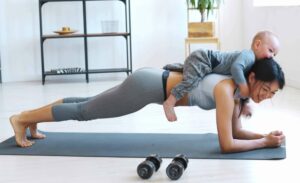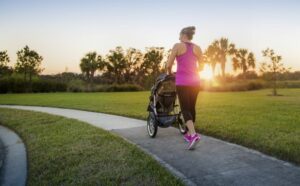Rest and sleep are key parts of maintaining physical health and recovering from potential injuries. This is true even outside of competition season. A recent study, done on preseason rugby athletes, found that longer sleep duration during the preseason may assist in enhancing physical qualities including aerobic capacity and body composition.
To ensure we stay healthy it is important we take care of our mental health. Often when feeling down it can be difficult to motivate yourself to exercise. However, recent research shows that even light to moderate level physical activity will lead to higher levels of perceived happiness and self perceived health leading to overall better mental health outcomes.
Exercise is a key factor in maintenance of good sleep quality. A recent study highlights that a sufficient amount of moderate – to high-intensity exercise can improve the quality of sleep and prevent insomnia. However, physical activity in the late evening may lower melatonin levels and negatively impact sleep.
Fitness trackers and other wearable tech have become increasingly popular in sporting and non-sporting populations. Researchers have determined that activity trackers tend to encourage wearers to take approximately 1800 extra steps per day, equivalent to approximately 40 extra minutes of walking.
Researchers’ understanding of overtraining syndrome (OTS) is guiding their advice for athlete return to sport in the case of post COVID-19 condition, also known as long-COVID. Those experiencing long-COVID should moderate their activity in the same way as overtrained athletes, with “symptom-titrated physical activity,” the gradual reintroduction of intensity based on close monitoring of an individuals’ symptoms. In the case of both OTS and long-COVID, there is no one-size-fits-all recovery.
People who play sports like soccer and rugby are familiar with yellow and red cards, tools for officials to warn or eject players from the game. A blue card is a new addition to rugby’s carding system. A blue card is initiated by an official when there is a suspected concussion. The blue card tool is now used for all rugby activities in Ontario.
Research shows that a high proportion of athletes are vitamin D deficient. Low vitamin D levels impact muscle strength and endurance, and increase risk for stress fractures. Athletes should monitor their vitamin D levels, especially during Canadian winters, when there is less exposure to sunlight.
The postpartum transition (from childbirth to one-year postpartum) is among the most challenging identity shifts a woman faces. She’s navigating mental and physical health changes, while caring for an infant (Deave et al., 2008). Despite knowing this challenge exists, women have limited supports available to assist with their postpartum transition. That leaves many women disoriented about their postpartum body and how to move forward. This lack of support may be associated with high rates of anxiety and depression among postpartum women.
Physical activity has the capacity to reconnect women with their new bodies, while reducing mental duress. However, new mothers don’t receive enough education on how to safely resume physical activity after childbirth. Fatigue, stress and depression make it even harder to return to physical activity.
After having my first child, I was well versed in the mental health challenges that can happen from a lack of postpartum support. As an exercise physiologist, I knew about the benefits of physical activity. But even with expertise in this area, I was overwhelmed by the lack of direction for returning to movement. After 4 days of labour, an emergency caesarean and a post-operative infection, the only advice I received was at my 6‑week obstetric follow-up appointment: return to exercise gradually.
 This blog post aims to bring light to the benefits of physical activity in the postpartum period. It also highlights the need for further support in returning to physical activity after childbirth. We’ve drawn on our research examining the benefits of an 8-week outdoor group exercise program for new mothers and the broader literature focused on physical activity after childbirth. We also provide an evidence-informed, step-by-step postpartum guide to returning to physical activity.
This blog post aims to bring light to the benefits of physical activity in the postpartum period. It also highlights the need for further support in returning to physical activity after childbirth. We’ve drawn on our research examining the benefits of an 8-week outdoor group exercise program for new mothers and the broader literature focused on physical activity after childbirth. We also provide an evidence-informed, step-by-step postpartum guide to returning to physical activity.
Exercise as medicine in postpartum
Advocating for physical activity as a component of healthcare isn’t new. In fact, Exercise is Medicine® was established in 2007, as part of a movement to change the way healthcare is delivered and chronic disease is prevented and managed. However, there’s little focus on maternal mental and physical health. And that’s despite there being many time points when intervention and support could be achieved through infant follow-up care. The concern is that physical activity levels decrease following childbirth with few women meeting the physical activity guidelines of 30 minutes of moderate to vigorous physical activity (Evenson et al., 2012). Research has also shown those physical activity guidelines lack postpartum specificity, in that they don’t relate specifically to these women (Evenson et al., 2014).
Given the challenges new mothers face and physical activity’s potential benefits, we aimed to assess the benefits of outdoor physical activity for new mothers. We designed a program involving outdoor group exercise for postpartum women, because the COVID‑19 pandemic restricted indoor exercise during our study period. All 21 participants had experienced childbirth less than 9 months before the program began. They could attend the outdoor classes twice per week for a 40-minute, group fitness class TONETM. Created by Les Mills International (Auckland, New Zealand), TONETM aims to strengthen core musculature, improve aerobic fitness and balance and increase muscular endurance. To reduce potential barriers to engaging with this exercise program, participants could bring their baby to the group fitness classes.
 We interviewed the mothers in our study to better grasp the challenges they faced with physical activity engagement and the role the program played in their mental and physical recovery. The new moms in our study described returning to physical activity as overwhelming. They were navigating their new bodies, different schedules (or lack thereof!) and fatigue. There were parallels to my experience with postpartum.
We interviewed the mothers in our study to better grasp the challenges they faced with physical activity engagement and the role the program played in their mental and physical recovery. The new moms in our study described returning to physical activity as overwhelming. They were navigating their new bodies, different schedules (or lack thereof!) and fatigue. There were parallels to my experience with postpartum.
For example, a mother stated her fear of being unable to return to physical activity:
“After I had my C-section, I felt like I was never going to move again… basically they follow you very closely [after] you have a baby and then they wish you the best… and you’re like okay, I just had major surgery but, um, what should I do?”
Our program was described as a required component of postpartum care, necessary to help mothers find their path to return to physical activity. Specifically, women described the need for an exercise program with other new mothers. One that created an inclusive and safe exercise environment, provided accountability and allowed them to gain confidence exercising with their baby.
Participants described access to a supportive physical activity program as essential. A participant stated:
“I think it should be mandatory for all new moms… it should be like you need to take postnatal exercise classes…so we can build some confidence… I’m more confident now. I’m emotionally strong, I’m physically getting stronger.”
A guide to becoming physically active after childbirth
 This advice is based on our research findings, my experience as an exercise physiologist and my knowledge of the broader literature on the benefits of physical activity postpartum on mental and physical health. We strongly advocate for an increase in education about and opportunities for new mothers to return to physical activity. We also suggest the following evidence-informed, step-by-step, postpartum guide to returning to physical activity:
This advice is based on our research findings, my experience as an exercise physiologist and my knowledge of the broader literature on the benefits of physical activity postpartum on mental and physical health. We strongly advocate for an increase in education about and opportunities for new mothers to return to physical activity. We also suggest the following evidence-informed, step-by-step, postpartum guide to returning to physical activity:
- 6 to 10 weeks: Have a maternity physician or obstetrician assess your readiness to return to physical activity.
- 10 to 16 weeks: Seek advice from a pelvic physiotherapist for clearance before you move on to more vigorous forms of physical activity.
- 16 to 24 weeks: Learn to gradually increase your strength and fitness. Ideally get instruction from a kinesiologist who specializes in postpartum fitness.
- After 24 weeks: As you return to your prenatal strength and fitness, you need access to continual education about how to overcome obstacles and form habits to get past mental and physical barriers that are likely present in the postnatal transition.
Lastly, to further reduce barriers, it’s vital that postpartum programming provides childcare during physical activity or allows women to bring their babies. Ensuring women are set up for optimal success as they navigate their identity in motherhood will have benefits for the whole family.
In conclusion, there’s a need for further education and support in the postpartum period. Physical activity has many benefits for new mothers. Additionally, group-based, supportive exercise for new mothers creates a socially supportive environment and accountability for them. New mothers should be given more specific guidelines on learning to return to movement, after childbirth and beyond.
